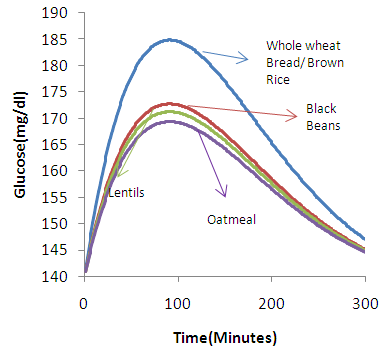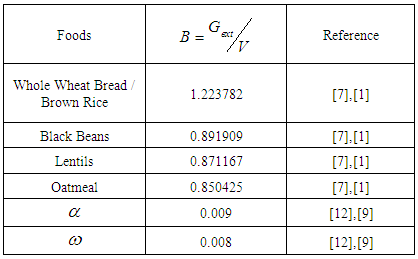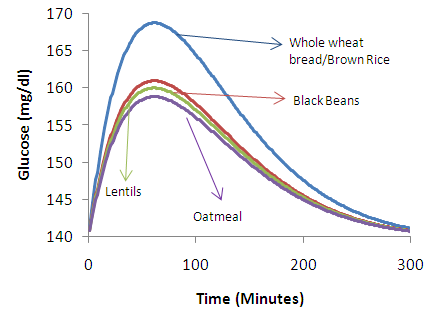Richa Gupta, Deepak Kumar
Department of Mathematics, Manav Rachna International University, Faridabad, Haryana, India
Correspondence to: Deepak Kumar, Department of Mathematics, Manav Rachna International University, Faridabad, Haryana, India.
| Email: |  |
Copyright © 2017 Scientific & Academic Publishing. All Rights Reserved.
This work is licensed under the Creative Commons Attribution International License (CC BY).
http://creativecommons.org/licenses/by/4.0/

Abstract
This work displays a numerical model of glucose metabolism including the digestion of carbohydrate as a factor affecting blood glucose concentration for type 1 diabetic patient. It includes a comparative study of glucose metabolism for different types of food: Black Beans, Whole Wheat Bread, Brown Rice, Lentils and Oatmeal. The model involves the differential equations for change in concentration of glucose, insulin and epinephrine in which factors for physical activities and carbohydrates affecting glucose concentration are also included. Graphs are drawn using the solution of the differential equations. This work represents glucose level picked up by various food items for both exercising and non-exercising person. It is concluded that there is a great impact of physical activities and eating habits in regulation of plasma glucose concentration for a type 1 diabetic patient.
Keywords:
Differential equations, Eating habits, Glucose metabolism, Mathematical model, Physical activities
Cite this paper: Richa Gupta, Deepak Kumar, Numerical Model for Glucose Metabolism for Various Types of Food and Effect of Physical Activities on Type 1 Diabetic Patient, Applied Mathematics, Vol. 7 No. 2, 2017, pp. 19-22. doi: 10.5923/j.am.20170702.01.
1. Introduction
Diabetes Mellitus is a syndrome of disordered metabolism characterized by very high blood sugar level. This high blood glucose is either due to body’s failure to produce insulin or due to body’s failure to respond towards insulin produced by the body itself. These two causes produce two types of diabetes: Type-1 diabetes mellitus and Type-2 diabetes mellitus respectively. Type-1 diabetic patients need insulin either by injection or by wearing an insulin pump as their body does not produce insulin. Type-2 diabetic patients do not need insulin. Type-1 diabetes is also an autoimmune disease arises when the immune system mistakenly killed the pancreatic beta cells. As a result insulin is not produced in the body. Due to this cessation of insulin secretion, type 1 diabetes arises [1]. Diabetes is the disorder of glucose metabolism in which oxidisation of sugar does not take place to produce energy due to lack of insulin [8]. Another type of diabetes is known as gestational diabetes, which arises during pregnancy. In many cases it cures automatically after pregnancy but if remains uncured then causes many complications [14]. Diabetes without proper treatment can cause many complications.In developing countries, due to adoption of western lifestyle with decreased physical activity and more consumption of fast food, the rate of increasing obesity has become tripled [4]. For achieving better quality of life in diabetic patients it is necessary to pay attention towards a preventive, predictive, personalized and participatory approach of treatment. Mathematical modelling of diabetic condition and its associated complications provide the deep and clear knowledge about the diverse and complex mechanism involved. A differential equation model has been proposed in this work. In this model the authors involved different factors affecting glucose metabolism. Change in concentration of Glucose and Insulin are considered. Concentration of Epinephrine also included in this model. Epinephrine is a hormone which is secreted by adrenal glands when there is the deficiency of glucose in our blood [3]. It helps to covert the stored glycogen in liver into the glucose and increase the concentration of glucose in the blood [3]. It is suggested to medical practitioners that they should encourage the physical activities and intake of limited calories to diabetic patients [2]. All kinds of physical exercise can help to take care of diabetic patients. Even little amounts of physical exercise can help. It is suggested to diabetic patients to do 30 to 60 minutes of moderate to vigorous physical exercise daily [9]. The work represents comparative analysis of glucose behaviour of different types of food items – Black Beans, Whole Wheat Bread, Brown Rice, Lentils and Oatmeal. Whole wheat bread and brown rice have a large amount of carbohydrates while oatmeal gives a less amount of carbohydrates. Lentils have fewer amounts of carbohydrates in comparison to Black beans. Based on this comparative analysis eating habits of a diabetic patient can be improved. The study explains the dynamics of glucose-insulin regulatory system with impact of physical exercise on a diabetic person from breakfast (8.00am) to lunch (1.00pm) i.e. 5hrs (0-300 minutes). When a meal containing carbohydrate is eaten, human body digests the carbohydrate and convert it into called glucose, which can then be used as energy by the cells in humans. Type –I diabetes is a condition where body can’t properly control the amount of glucose in blood.The authors propose a mathematical model of glucose regulatory system for type-1 diabetic patient including the impact of carbohydrate by different food items on glucose level in the blood. The model also includes effect of physical activities on the blood glucose level. There is the direct effect of activities in carbohydrate metabolism. The entry of glucose into skeletal muscles is increased in the obscene of insulin [11]. During exercise absorption of injected insulin is more rapid. As a result muscles uptake of glucose increases [11]. Healthy eating habits play an essential part of controlling the Type 1 diabetes. The concentration of glucose in the blood in a non-diabetic person lies in the range of 80 – 110 mg/dl under the fasting condition [10].
2. Mathematical Model
 | (1) |
 | (2) |
 | (3) |
 - Blood Glucose Concentration
- Blood Glucose Concentration - Blood Insulin Concentration
- Blood Insulin Concentration - Epinephrine
- Epinephrine - Effect of physical exercise in increasing the utilization of Glucose
- Effect of physical exercise in increasing the utilization of Glucose - Effect of physical exercise in accelerating the utilization of Insulin
- Effect of physical exercise in accelerating the utilization of Insulin  - Output of carbohydrate metabolism system
- Output of carbohydrate metabolism system - Volume distribution space
- Volume distribution space are constants.
are constants.
3. Mathematical Analysis
Differentiating equation (1) w. r .t. t in the above model, we obtain: | (4) |
Substituting for  and
and  from equation (2) and (3) respectively in equation (4), we get:
from equation (2) and (3) respectively in equation (4), we get: | (5) |
Assuming  and from (1),
and from (1),  | (6) |
This is in the form of: | (7) |
Where  | (8) |
 | (9) |
 | (10) |
Solution of equation (7) is | (11) |
Where  If
If  then equation (11) gives
then equation (11) gives | (12) |
If  then
then  , so that
, so that  . Also, integrating (7), we get
. Also, integrating (7), we get | (13) |
So that  | (14) |
Which gives  and leads to the solution
and leads to the solution | (15) |
Where,  .Case 1. If a type 1 diabetic patient is not doing physical activities
.Case 1. If a type 1 diabetic patient is not doing physical activities | Figure 1. Blood Glucose level with respect to time for different types of food without physical activities |
Table 1. Parameters Estimations
 |
| |
|
Table 2. Parameter estimation in case of without physical activities
 |
| |
|
The figure 1 represents concentration of glucose in blood for different types of food items when the diabetic patient does not perform physical activities. The above graph displays the solution of equation (15) using the parameters estimation of Table 1 and Table 2. Glucose level in blood becomes very high after eating whole wheat bread and brown rice while it is not too much high in case of oatmeal and lentils. It is easily understandable that oatmeal, lentils and black beans are better option for food in comparative to whole wheat bread and brown rice for a diabetic person.Case 2. If a type 1 diabetic patient is doing physical activitiesTable 3. Parameter estimation in case of with physical activities
 |
| |
|
 | Figure 2. Blood Glucose level for different types of food with physical activities |
The figure 2 represents blood glucose concentration for different types of food items when the diabetic patient performs physical activities. The above graph displays the solution of equation (15) using the parameters estimation of Table 1 and Table 3. The gain of glucose from whole wheat bread and brown rice is greater than the others. If we compare this value between exercising and non-exercising patient then it is less in case of exercising patient, which means activities have direct effect on glucose metabolism.
4. Conclusions
The level of carbohydrate in diet of diabetic patient is the most important factor influencing blood glucose levels after a meal. This work represents a glucose metabolism based mathematical model for type 1 diabetic patient. The solution of differential equations is represented in graphical form which describes the blood glucose concentration in body for different types of food for exercising and non-exercising diabetic patient. It is suggested that the concentration of glucose in blood plasma can be decreased by doing physical activities for a diabetic patient and also it can be controlled by improving eating habits according to the gain of carbohydrates from different food items and by doing some physical activities.
ACKNOWLEDGMENTS
The authors wish to thank DR. SHILPA CHAPADGAONKAR, Dept. of Biotechnology, Manav Rachna International University, Faridabad, Haryana for helpful and insightful discussion concerning this work.
References
| [1] | Claudia Cecilia Yamamoto Noguchi, “Mathematical Model of Glucose-Insulin Metabolism in Type 1 diabetes Including Digestion and Absorption of Carbohydrates”, SICE JCMSI, Volume-7, Issue-6, Page No (314-320), 2014. |
| [2] | Ibrahim Isa Adamu, Yusuf Haruna and E.J.D. Garba, “Mathematical Model for the Dynamics of Glucose Regulatory System under the Combined Effect of Dieting and Physical Activity”, International Journal of Pure and Applied Science Technology, Volume -1, Page No (88-100), 2014. |
| [3] | B. Kwach, O. Ongati and R. Simwa, “Mathematical Model for Detecting Diabetes in the Blood”, Applied Mathematical Sciences, Volume-5, No. 6, Page No (279-286), 2011. |
| [4] | Lt. Gen. S.R. Mehta, Col. A.S. Kashyap and Lt. Col. S. Das, “Diabetes Mellitus in India: The Modern Scourge”, MJAFI, 65, Page No (50-54), 2009. |
| [5] | Brian Topp, keith Promislow, Gerda De Vries, Robert M. Miura and Diane T. Finegood, “A Model of β-Cell Mass, Insulin, and Glucose Kinetics: Pathways to Diabetes”, J. theor. Biol, 206, Page No (605-619), 2000. |
| [6] | F. Stahl, R. Johansson, “Diabetes mellitus modeling and short-term prediction based on blood glucose measurement”, Elsevier- Mathematical Biosciences 217, Page No (101-117), 2009. |
| [7] | Complex Carbs and Blood Sugar: Ketogenic Diet Resource, http://www.ketogenic-diet-resource.com/complex-carbs.html, August 3, 2016. |
| [8] | V.K. Katiyar, K.S. Basavarajappa, G. Manjunatha, K.S. Onkarappa and S.S. Naik, “Mathematical Modeling on Diabetes Mellitus under the Administration of Quantitative Diet using Joslin’s principle for various Body Frames”, Indian Journal of Biomechanics: Special Issue, NCBM, Page No (41-45), 2009. |
| [9] | Sandhya and Deepak Kumar, “A mathematical model on glucose insulin regulatory system with the impact of physical activities”, Computational and Mathematical Biology, Issue 5(1), (2016). |
| [10] | Jamal Hussain and Denghmingliani Zadeng, “A mathematical model of glucose-insulin interaction”, Science Vision, vol. 14(2), Page No (84-88), 2014. |
| [11] | S.O. Adewale, O.A. Ajala, K.O. Obisesan and O. Adebimp, “Impact of Exercise on Diabetics Subjects”, Research Journal of Applied Sciences 2(6), Page No (708-711), 2007. |
| [12] | J. N. Kapur, “Mathematical models in biology and medicine”, East-West Press Private Limited, Reprint- 2010, ISBN: 81-85336-82-2. |
| [13] | Sandhya, Deepak kumar, Prerna Pandit, “An Ordinary Differential Equation Model of diabetic population in New Delhi”, Indian J. of Mathematics and Mathematical Sciences, Vol.7, Page No (45-50), (2011). |
| [14] | Richa Gupta, Deepak Kumar, “Model of Gestational Diabetes- Impact on Placental Volume and Fetus Weight”, IEEE: International Conference on Computing for Sustainable Global Development, ISSN 0973-7529; ISBN 978-93-80544-20-5, pp (5513-5517), March 16-18, 2016. |






 - Blood Glucose Concentration
- Blood Glucose Concentration - Blood Insulin Concentration
- Blood Insulin Concentration - Epinephrine
- Epinephrine - Effect of physical exercise in increasing the utilization of Glucose
- Effect of physical exercise in increasing the utilization of Glucose - Effect of physical exercise in accelerating the utilization of Insulin
- Effect of physical exercise in accelerating the utilization of Insulin  - Output of carbohydrate metabolism system
- Output of carbohydrate metabolism system - Volume distribution space
- Volume distribution space are constants.
are constants.
 and
and  from equation (2) and (3) respectively in equation (4), we get:
from equation (2) and (3) respectively in equation (4), we get:
 and from (1),
and from (1), 





 If
If  then equation (11) gives
then equation (11) gives
 then
then  , so that
, so that  . Also, integrating (7), we get
. Also, integrating (7), we get

 and leads to the solution
and leads to the solution
 .Case 1. If a type 1 diabetic patient is not doing physical activities
.Case 1. If a type 1 diabetic patient is not doing physical activities

 Abstract
Abstract Reference
Reference Full-Text PDF
Full-Text PDF Full-text HTML
Full-text HTML

